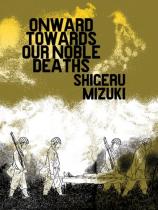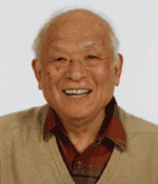Onward Towards Our Noble Deaths
Review
Onward Towards Our Noble Deaths
Onward Towards Our Noble Deaths chronicles the last days of a doomed unit of the Japanese Imperial Army in the last days of World War II. In an afterword, Shigeru Mizuki describes the story as "90 percent fact," and because it is drawn from his own experiences in a very similar unit, it is at heart 100 percent true. Like Maruyama, the main character in the book, Mizuki was an enlisted man in a unit in Raibaul, which is now part of Papua New Guinea, and like Maruyama, he lost all his army buddies in the war.
The first half of the book is a tale of steadily increasing misery; The soldiers are poorly fed, suffering from untreated diseases, and forced to work in dangerous conditions. Enlisted men were regarded as less than human by the Japanese army brass, who refer to them as "worms." Nonetheless, their humanity shines through in their vastly different personalities, their memories of home, and their humor. Even the cruel Sergeant Honda, who dispenses blows as casually as orders, shows rare empathy when he gives his boot to Maruyama (who lost his in a gross but funny incident involving a latrine and a rice bucket) and declares his intention to go barefoot. The soldiers may be less than human to their commanders, but they are very much alive to the reader—which makes it so terrible when we see them die horribly, one by one, from jungle diseases, accidents, or just plain stupidity.
As the book progresses, the enemy closes in, and the Japanese commander, Tadokoro, makes the decision that the unit must hurl itself against the Allies in one last suicide charge. This is not the only option, or even the best one—the charge will buy the soldiers behind them a few days at most, while Tadokoro's staff argues that if they retreat to the mountains and fight guerilla-style, they can hold off the enemy for months. Tadokoro is convinced that it is nobler to face the enemy directly and die in battle, and he is determined to lead his soldiers to this noble death.
What follows is not what was expected: A portion of the unit survives the attack, presenting a problem for their commanders in the rear (who opposed a suicide charge to begin with). The soldiers' deaths have already been announced; Their nobility has been celebrated. The conversations that follow are worthy of the finest wartime satire, as the commanding officers debate whether to send the men back to their deaths or spare the useless carnage. Even the superior officers have their doubts, especially when it comes to compelling individual soldiers to commit suicide, but in the end, the Japanese sense of honor wins out over human empathy.
Mizuki's style is rather odd and a bit jarring at first: He draws the soldiers as simple, cartoonlike caricatures and lavishes a great deal of detail on the backgrounds, rendering the battleground scenes with almost photographic detail. While this is a bit jarring at first, the soldiers' cartoony faces convey their personalities quickly to the reader. Mizuki does not spare the reader the horrors of war; deaths and injuries are depicted in gruesome detail, and when, at the end, a gravely wounded Maruyama suddenly has a realistic face, the effect is horrific.
The book includes a foreword by scholar Frederick Schodt, an afterword by Mizuki, an interview with Mizuki, and extensive translators' notes, all of which help the reader place the story in its proper context and understand some of the cultural nuances (such as the songs the soldiers sing during the worst of times). These are all helpful, but at its essence, Onward Towards Our Noble Deaths is a story that anyone can understand, a story of both the nobility of human spirit and the absurdity of war.
Reviewed by Brigid Alverson on July 10, 2012
Onward Towards Our Noble Deaths
- Publication Date: April 26, 2011
- Genres: Graphic Novel
- Paperback: 368 pages
- Publisher: Drawn and Quarterly
- ISBN-10: 1770460411
- ISBN-13: 9781770460416




